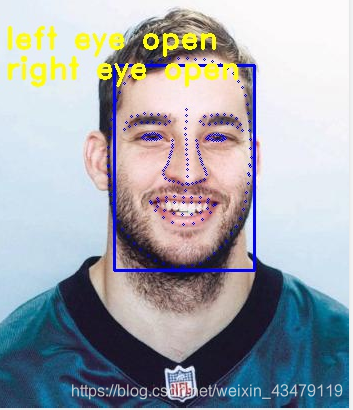1 Ultra-Light-Fast-Generic-Face-Detector-1MB简介
用户 Linzaer 在 Github 上推出了一款适用于边缘计算设备、移动端设备以及 PC 的超轻量级通用人脸检测模型,该模型文件大小仅 1MB,320x240 输入下计算量仅 90MFlops。项目推出不久即引起了大家的关注,登上了今天的 Github trending。
github地址:https://github.com/Linzaer/Ultra-Light-Fast-Generic-Face-Detector-1MB
2 生成自己需要的label
因为Ultra-face需要使用 voc的数据格式, 所以我这里是使用的yolo的数据集格式转变为voc的格式。
我这里用的是FDDB数据集,因为FDDB数据集没有标签我们要生成人眼的标签。首先使用
https://github.com/OAID/TengineKit/tree/master/Linux/sample/FaceDemo
TenginekIT 是定位人脸221个关键点输出txt文档

然后根据212人脸关键点中人眼的关键点定位眼睛的中心位置和w,h。生成yolo的数据格式
finame label x_c Y_c w h
代码段
f = open("test.txt") # 返回一个文件对象
lines = f.readlines()
for i in range(1,16909,2):
line = lines[i]
arr = line.split(',')
x = int(arr[252]) + int(arr[236])
y = int(arr[253]) + int(arr[237])
w = int(arr[236])-int(arr[252])
h = int(arr[260])-int(arr[244])
x=x/2
y=y/2
w=w/2*6
h=h/2*8
#挑选出图片中眼睛较小的图片
if w < 10:
t = lines[i - 1]
newname = line.replace(line, t)
newfile = open("1.txt", 'a')
newfile.write(newname)
newfile.close()
if 超轻量级人脸检测模型与数据处理
超轻量级人脸检测模型与数据处理





 用户Linzaer发布了一款仅1MB大小的超轻量级人脸检测模型,适用于边缘计算和移动端。该模型在320x240分辨率下计算量仅为90MFlops。文章介绍了如何将FDDB数据集转换为模型所需的VOC格式,通过TengineKit获取关键点信息,然后利用Python代码生成符合YOLO格式的标注文件,并处理了可能导致训练时loss为nan的问题。
用户Linzaer发布了一款仅1MB大小的超轻量级人脸检测模型,适用于边缘计算和移动端。该模型在320x240分辨率下计算量仅为90MFlops。文章介绍了如何将FDDB数据集转换为模型所需的VOC格式,通过TengineKit获取关键点信息,然后利用Python代码生成符合YOLO格式的标注文件,并处理了可能导致训练时loss为nan的问题。
 最低0.47元/天 解锁文章
最低0.47元/天 解锁文章

















 978
978

 被折叠的 条评论
为什么被折叠?
被折叠的 条评论
为什么被折叠?








